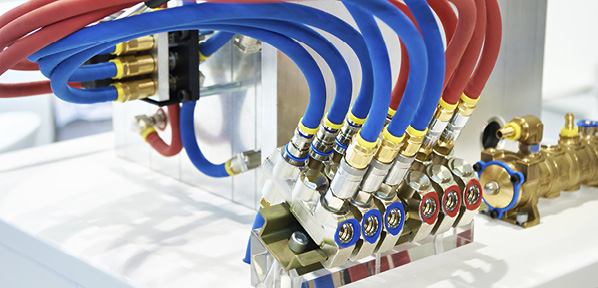What is Fluid Power?
Challenging Conventional Thinking
 By Andrew Smulski, President, Fluid Conveyance, Danfoss Power Solutions.
By Andrew Smulski, President, Fluid Conveyance, Danfoss Power Solutions.
If you were asked to envision a fluid power application, what would come to mind? Depending on your role in the industry, it might be a tractor pulling an implement over rolling hills or an excavator moving dirt at a construction site. Perhaps it’s an injection molding machine or a hydraulic press operating in a factory humming with activity. These would all, of course, be logical examples of fluid power.
But what about the rows of racks in a modern data center? Or the electric vehicles parked at a nearby charging station? Would you consider those to be fluid power applications? I do – let me explain why.
Fluid power has always included hydraulics and pneumatics. (Those of us on the hydraulics side of the business sometimes forget that a fluid can be a liquid or a gas.) If fluid power means the transmission of power from one place to another via liquid or gas, then applications such as thermal management can be considered fluid power. We’re transmitting cooling power to batteries or servers or other components that need it.
Fluid power is evolving beyond hydraulics and pneumatics. It now includes software, cloud services, electronic controls, and automation – in other words, much more than the components we’ve traditionally supplied. As an industry, we’ve struggled with this idea. Look no further than the abundant “Are electrics going to take over hydraulics” articles as proof. We faced the same moment of reckoning when electrohydraulics emerged a few decades ago. And yet here we are.
We’ve always thought of ourselves as one type of industry with a defined set of markets. This needs to change. As we did then, we continue to evolve with the times: we embrace change, find new markets, and develop new competencies. And this is important as we enter what’s predicted to be a down cycle this year. Construction and agriculture equipment spending may slow, but other markets are seeing significant investments: infrastructure, civil projects, industrial facilities, and data centers are among them.
Data centers are one of the fastest-growing markets. These facilities require a significant number of hoses and fittings as the industry turns to more efficient liquid cooling methods. Electric vehicles have more hydraulic content (in the form of hoses and fittings) than traditional combustion engine vehicles because of the thermal management and cooling needs. And let’s not forget the pneumatic side of the business. Many modern warehouses and fulfillment centers use fluid power-based automation technologies.
The point is, regardless of the macro environment, there is a growing market for fluid power components because of new entrants and adjacencies as well as new technologies. As we think about who we are, we need to challenge conventional thinking about what fluid power is, and which markets we play in. With this will come a need to expand our world of partnerships and relationships. Thermal management entails working with HVAC and climate customers which was rarely the case in the past.
So how should we define fluid power today? A perhaps overly simplistic approach might be to consider it this way: If there’s a hydraulic or pneumatic component involved – whether hose or valve or cylinder – it’s fluid power. This definition opens up a world of opportunities – including many in electrification! And to be clear, lest you didn’t get the message from one of those “death of hydraulics” articles, fluid power is here to stay.







